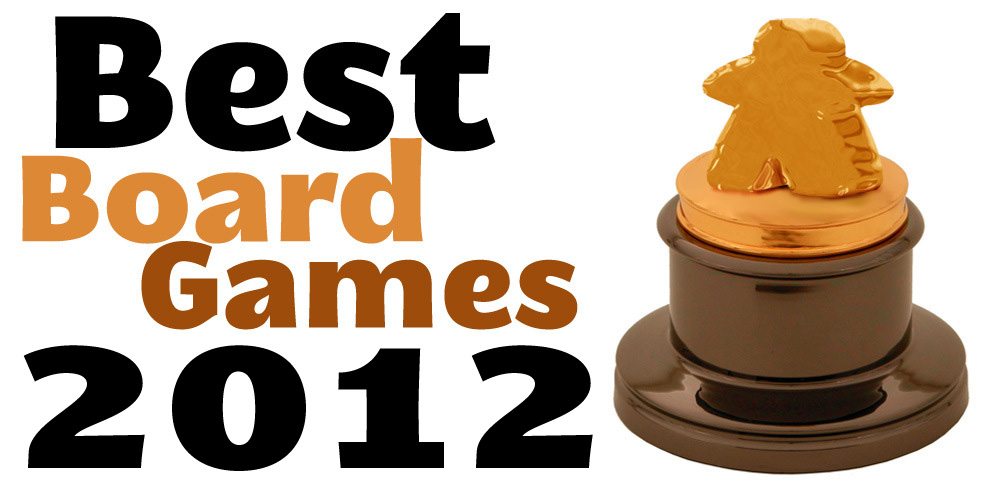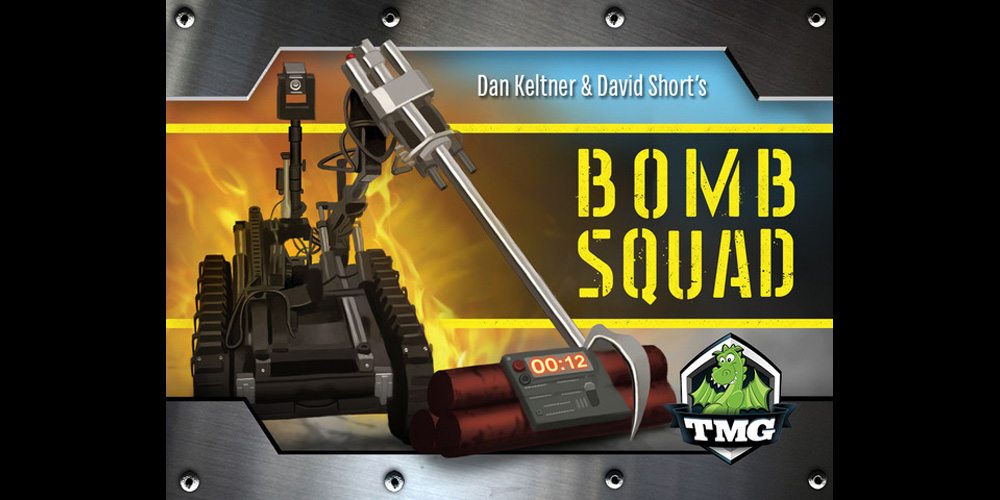
 Overview: Your food is at war: First Sergeant Fish Stick is up against a platoon of Private Pancakes — fortunately he’s joined by a Tank o’ Fries, and they brought Ketchup Mechanic with them. It’s a triumph at Spaghettis-burg! Food Fight is a new card game from Cryptozoic, filled with belligerent food and plenty of punnery.
Overview: Your food is at war: First Sergeant Fish Stick is up against a platoon of Private Pancakes — fortunately he’s joined by a Tank o’ Fries, and they brought Ketchup Mechanic with them. It’s a triumph at Spaghettis-burg! Food Fight is a new card game from Cryptozoic, filled with belligerent food and plenty of punnery.
Players: 2 to 6
Ages: 13 and up (younger players may be able to handle it as well)
Playing Time: 30 minutes (will vary depending on number of players)
Retail: $29.99
Rating: Yummy! Food Fight takes the traditional game of War and makes it both strategic and hilarious.
Who Will Like It? It helps if you have an appreciation for puns and food humor, but even apart from that the game is quite enjoyable. It’s a game for people who don’t mind taking a little time to read the cards; there’s a bit of a learning curve at the beginning, but the effort pays off.
Theme:
It’s all about food and war. The troops are all dishes from breakfast, lunch, and dinner. There are also condiments (like Medic Mustard and Ketchup Mechanic) which can boost the “yumminess” of your troops, and there are Mascots like Candy Warhol or Crun-Che Taco. The artwork is terrific, reminiscent of those old Mad Magazine fake-product ads, right down to the sepia-toned, worn look of things. You get fun combinations like chicken and waffles: Private Waffle gets a yumminess boost for every General Chicken on the table.
All of the terms have to do with food as well: the battles take place over a particular meal, and each individual fight is called a “Serving.” Preparing your army for battle is “plating.”
The rules actually start with a story that fills the first two pages — it’s a bit over the top and I didn’t actually read it all until just now while I was typing up the review. It is, like many game back-stories, completely unnecessary, but it’s a fun touch and shows that they really went all out in setting the mood for the game.
Components:
Food fight comes with:
- 6 sets of 3 plates (Breakfast, Lunch, and Dinner)
- 27 Battlefield cards (Breakfast, Lunch, and Dinner)
- 8 Dog cards
- 18 Mascot Instants cards
- 16 Regular Instants cards
- 121 Food Troops cards
- 9 scoring chips
- 1 cardboard Food Fight stand-up sign (just for kicks)
The dinner plates and scoring chips are cardboard punch-outs, and everything else is cards. As I mentioned before, the artwork on the cards is fantastic, and nearly everyone I’ve played with has really liked the artwork and the food-based humor. I should note that it is violent: the food looks downright mean, and most of it is carrying guns or knives (or both). The game is rated 13 and up, and I’d guess it’s mostly for the war imagery, not the difficulty of the gameplay.
Gameplay:
The object of the game is to collect 10 victory points by winning Battlefield cards (which are worth from 1 to 3 points each).
Here’s what happens each “Day”:
- Reveal 3 Battlefield cards
- Deal 9 cards to each player
- Draft a hand of 9 cards
- Create an army of up to 5 troops
- Place a plate face-down on your army, indicating which meal you are fighting for
- Reveal plates
- Fight in order: Breakfast, Lunch, Dinner
- Winner of each meal collects Battlefield cards
- Discard all cards in hand and in play, and start the next Day
The Battlefield cards represent Breakfast, Lunch, and Dinner, and show the number of victory points that meal is worth. However, it is possible to turn up more than one card for a single meal — Breakfast might be worth 5 points, and Lunch may have no cards at all. That just means that the fighting will probably be more fierce for the higher-point meal.
The drafting step is usually skipped the first round, but once players have a hang of how the game works it should be incorporated. Basically you take the 9 cards you were dealt, keep one and pass the rest. Then you take the 8 that you receive from the next player, keep one of those and pass the rest. You continue until you’ve built a hand of 9 cards, and then continue.
You build an army, usually based on what meal you’re fighting for and what sort of combinations you have in your hand. The troops are all marked as Breakfast, Lunch, or Dinner, but they can be sent to fight for any of the meals. The main thing is that troops that match the meal win ties. Many of the troops also offer bonuses for different combinations. For example, General Chicken gives the rest of your Dinner troops +4 to their yumminess. Corporal Taco lets you discard Lunch troops from your hand for extra yumminess. You pick up to 5 troops, place them face down in a stack, and then pick the plate of the meal you’re fighting for and put it face down on your army.
Once everyone has “plated” their armies, everyone reveals their plates, and the battles begin.
For each meal, everyone involved shuffles their 5-card army and then flips over the top card. The card with the highest yumminess wins that Serving and takes a scoring chip. But wait! First you figure in any bonuses, and players also have the opportunity to add an Instant to their troop: these are condiments and mascots that add yumminess or give other abilities to the player. Once that Serving is resolved, everyone flips the next card, and so on. Note that bonuses only have an effect if your cards come up in the correct order: if General Chicken (with his +4 to Dinner troops) shows up last, then his bonus doesn’t help in already-completed Servings.
When all 5 Servings have been resolved, the player with the most scoring chips for the meal takes all of the associated Battlefield cards. If there’s a tie, then all tied players draw a card from the Dog deck, and highest card wins.
The meals are resolved in order: Breakfast, Lunch, and Dinner, and then all cards are discarded (including unplayed cards in your hand) and the next day begins.
The Dog will also show up if only one player chooses a meal. The Dog’s cards range from 5 to 10, but also include a 0 card and a 20 card, though none of the Dog’s cards have any special effects. Ties go to the player. If you get at least 3 scoring chips, then you win against the Dog and get the Battlefield cards. If not, the Dog wins and the Battlefield cards go to the bottom of the deck.
First player to 10 points wins the game.
Conclusion:
Food Fight caught my eye at PAX this year, largely because of the artwork. When we first got it out to play, I was a little overwhelmed by the rules, and by the amount of text on the cards. When you have a hand of 9 cards and you’re trying to read what they all do, it can feel like nothing’s happening — sort of like the first time you play a game of Fluxx. That, and the fact that it is at base the game of War (higher number wins the fight), made me wonder if it was a game that was all surface glitz with no substance. Don’t worry: Food Fight is indeed a meaty game.
It actually reminded me that when I was younger, I wondered if there was a way to turn War into a strategic game rather one of pure luck. I think at the time my best thought was that you’d draw three cards, and get to place them in one of three positions, but even that doesn’t really change the odds much (particularly if you’ve already lost most of your Aces). Food Fight, with its modifiers and bonuses, gives you the chance to build up an army that works well together, but there’s still an element of the unknown since you can’t put your troops in a specific order.
The drafting mechanic does take a lot longer than simply dealing 9 cards and playing with them, but it is actually a crucial part of the game. For one, if you’re dealt a hand and receive a whole lot of Instants, you may not actually have 5 troops to build an army, which puts you at a disadvantage for a battle. But also, the drafting also balances out the luck of the draw: if you get a pile of really great cards and your opponents get a hand of duds, you both still have a chance to win (and lose). Building your hand becomes a valuable part of the game strategy, and adds a lot of depth and evens the playing field.
The modifiers and bonuses are pretty clever, and do serve to balance out the game pretty well. In fact, there isn’t really such a thing as a dud card: it really depends on what else you put in your hand. Weaker troops often have big bonuses, or can be discarded to add to other troops. Even Big Bad Bacon, the yummiest single troop (he goes to 11!) has a weakness: if the Dog shows up, he’s instantly eaten.
So far everyone I’ve played this with has enjoyed it, once we get going. The game does have something of a slow start when you’re learning it, but that’s mostly due to reading all the cards and figuring out what they do (particularly the mascots). But as you get familiar with the cards, you can skim them quickly to figure out your best combos.
I’ve really enjoyed Food Fight and I think Cryptozoic has done a superb job with their first original game. (All of their other games have been licensed properties, but this one is their own from start to finish.) It’s fun and funny, and looks great to boot. The instructions mention a version for the iPad/iPhone but it’s not available yet — I’m looking forward to that as well, to see if the excellent gameplay carries over to the digital format.
You can purchase Food Fight directly from Cryptozoic, as well as Amazon and your local games retailer. Be sure to visit Cryptozoic’s site for some how-to-play videos and an amusing unboxing video by creator Cory Jones.
Wired: Fantastic artwork, food puns, and a strategic re-imagining of the classic card game War.
Tired: A bit slow to get stared the first time through.
Disclosure: GeekDad received a review copy of this game.







